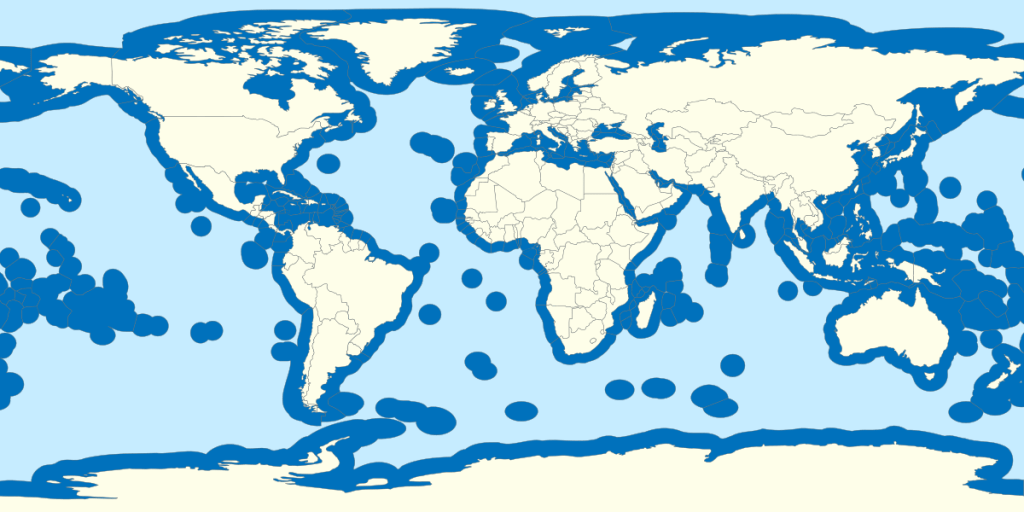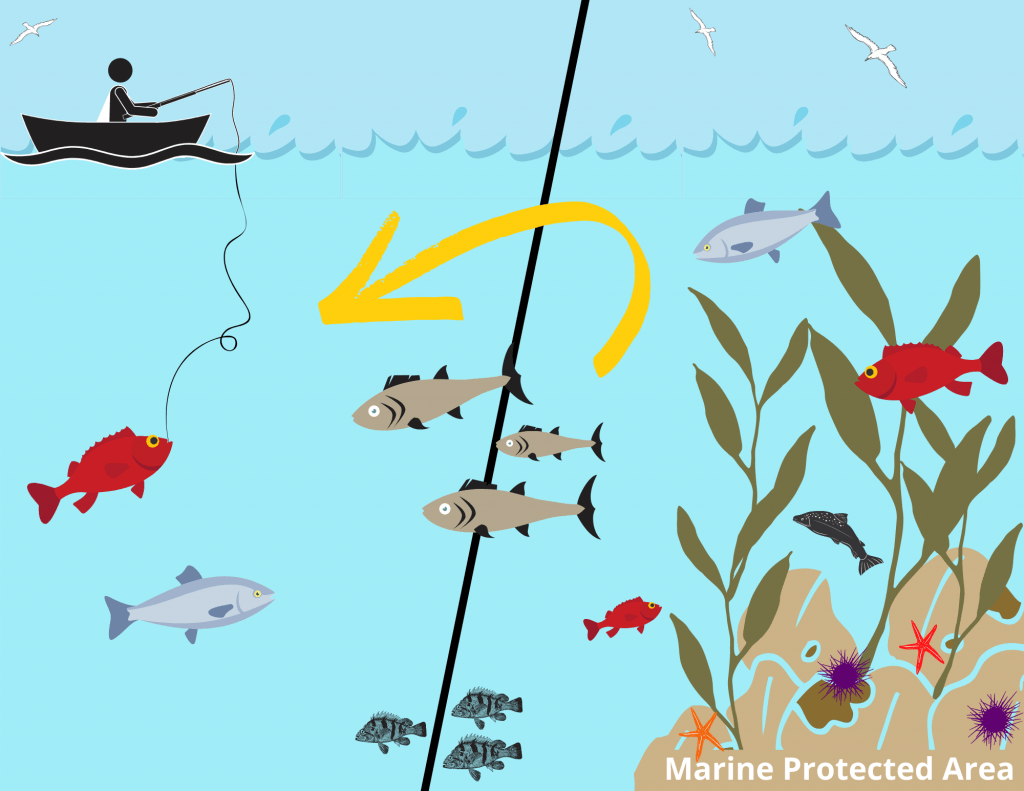What are the High Seas?
The high seas are an important part of earth’s network of ecosystems as they are home to many marine and pelagic species. Conserving these resources and stopping overfishing in the high seas is therefore very important. The high seas cover 2/3 of the ocean, so the area is home to a wide array of species including many threatened and protected species. They are breeding grounds and comprise part of the migratory routes for many iconic species. This article explores one scheme of many to protect marine life.
The high seas are the wild west of the oceans. Legally, the high seas are predominantly unregulated and lawless. So, who is responsible for the regulation and ownership of ocean resources in the high seas? As outlined in the 1982 United Nations Convention on the Law of the Sea (UNCLOS), all countries’ jurisdiction extends up to 200 nautical miles (nm) from the coastline. All areas beyond the 200nm limit are considered the high seas. The high seas are international waters that are not governed by any one country. Much human activity continues to occur within these oceans.

The Convention on the High Seas saw 63 signatories define the high seas as international waters, but areas in which states continue to have rights to fishing, overflights, construction (pipelines), and scientific research. The “High Seas Biodiversity Treaty” also known as the conservation of Biodiversity Beyond National Jurisdiction (BBNJ) has been proposed for states to negotiate under the United Nations within UNCLOS to reach a new international agreement on the protection and sustainable use of the high seas.
Why Are High Seas Important?
The high seas are home to a range of ecologically, scientifically, and economically crucial resources. Around 3 billion people globally rely heavily on the ocean for their livelihoods. Some of the most biodiverse ecosystems are found in the high seas, which can be thought of as a network of ecosystems and interspecies connections. However, the high seas are facing increased pressure from the impacts of pollution, climate change, and most importantly overexploitation of resources. International agreements allow the sustainable extraction of marine resources from these areas, but more work needs to be done on stopping overfishing. They allow the transfer and improvement of marine technology, use of environmental impact assessments, and comprehensive studies on changing climates and the impacts on species populations.
Agreements also help to better regulate human rights issues aboard fishing vessels, including rights to access, and they reduce maritime conflicts. Thriving in a world which relies on the high seas for our way of living will require sufficient regulation.
The Problem With Overfishing in the High Seas
The high seas contributes approximately 2.4% (4.3 million metric tons) to the global seafood industry with China, Taiwan, Japan, Korea, and Spain accounting for 80% total catch recorded (Schiller, Jennfier-Jacquet & Sala 2018).
As the demand for seafood increases, the requirements for commercial fishing fleets to land larger volumes of stock also increases. Additionally, as technology advances, commercial fishing fleets are able to say out at sea for longer. They are also able to land larger volumes of fish at a time, and fish deeper parts of the oceans. Modern fishing technology coupled with demand and the unregulated nature of the high seas allows for exploitation. This is driving many fish stocks to extinction.
New technologies also mean that levels of bycatch from commercial fishing are skyrocketing. Trawling, which is the act of dragging large nets across the bottom of the ocean, also leads to the destruction of coral and seafloor habitats, which can take decades to fully recover. A large portion of the species that primarily inhabit the high seas are larger pelagic fish and mammals, which are often vulnerable to extinction from trawling and bycatch because they take longer to replenish their population numbers. Recently, we have seen a 60% average stock decline in tuna, billfishes, and other fish relatives.
What defines overfishing?
For a fishery to become sustainable, we must consider the maximum sustainable yield and the maximum economic yield. If the number of fish being extracted is faster than the fish can reproduce, the fish stocks will decline. To be sustainable, the number of fish taken must be under this growth rate.
The highest level of growth of a particular population would define the highest sustainable yield allowed for fish extraction. Secondly, the maximum effort (size of ship, time at sea, depth of extraction) must not outweigh the volume of fish landed. If population levels are low, more effort is required to find available stocks. Maximum economic yield is defined when the total costs (efforts) of fishing are not outweighing the total revenue and profit of the fish stocks. As the high seas continue to be exploited to dangerous levels, the cost of fishing rises due to inefficiency.
Why Stopping Overfishing is Important
The oceans in the high seas are a free-for-all with no real regulation or management. Without regulation, stocks deplete much faster than the reproduction rate. As this escalates, a secondary risk of a humanitarian crisis also increases. As fisheries begin to cut costs, humans suffer worse conditions. Additionally, there are drastic implications for migratory species, whose populations could take decades to fully recover. This is part of why stopping overfishing is pivotal.
The cost of fishing in the high seas, balanced with fish prices equals the total revenue. Current levels of revenue from overfishing the high seas is not sustainable. Stopping overfishing may threaten current economic configurations. Fleets use forced labour to cut costs and maximise profits, which involves human slavery and trafficking. High seas fisheries also rely on large subsidies. Approximately 4 million US dollars is thrown into global high seas fishing each year. Without subsidies, only half of profitability remains. So, why not protect these areas which aren’t profitable in the first place? Why no create a marine reserve to allow fish stocks to flourish and thrive? It could be more than worth it to focus on stopping overfishing in the high seas, rather than extracting these resources for little benefit.
What is 30% by 2030?
Marine protected areas (MPAs) are a means to create a no-take marine reserve restricting all human activity, particularly fishing. Currently, only 2% of the ocean is protected as a MPA with only <1% as fully no-take zones. An MPA is a portion of the ocean where human activity is either strictly managed or completely prohibited in order to protect marine biodiversity.
The UN has proposed for 30% of each marine habitat to be established as either highly protected or fully protected MPAs. The aim is to cover at least 30% of the global ocean by the year 2030.
The Benefits of Protecting Fisheries
Establishing well connected MPAs within ecologically significant zones could see major benefits. No-take zones and highly protected MPAs are important not only for marine ecosystems but for human livelihoods. No-take MPAs could allow fish populations to thrive and replenish.
As populations increase fish stocks will begin to increase and ‘spill over’ beyond the boundary of the MPA. As abundance increases beyond the no-take zones, fisherman will be able to take from the ‘spill over’. This creates a stable flow of fish beyond the MPA available for fisherman to extract and land for revenue. As the fish populations inside the MPA remain untouched, the fish stock becomes more stable. MPAs could allow fisherman on the high seas to reap the benefits of a stable fish stock if used well.
It is important to consider where the MPAs are placed and ensure ecologically significant locations are of primary focus, rather than establishing an MPA in less productive area. This would help migratory species to increase in abundance and ‘spill over’ to fishable sections on the ocean. This provides fisherman with a more abundant fish stock to extract, with also the ability to allow fish stocks to replenish within the MPA boundaries.

extract the fish. Courtesy California Marine Sanctuary Foundation.
Are We on Track for 30% by 2030?
Unfortunately, the COVID-19 pandemic saw a halt in important discussions. Negotiations between authorities to establish effective management strategies and regulation policies are yet to be fully agreed upon. Protecting the high seas is a complex problem and will require cooperation from many government agencies and organisations. However, the future for marine species would drastically improve. If we want to thrive in a more sustainable world, the high seas is where our attention should be.
If you want to know more about protecting fisheries in the high sea, check out THRIVE Project and subscribe to our newsletter.























